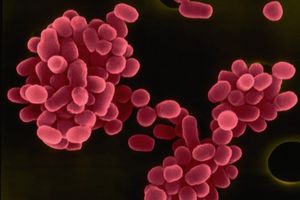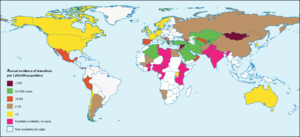Zoonosis: Brucellosis in Animals and Humans: Difference between revisions
| Line 5: | Line 5: | ||
Brucellosis is among the most common and highly contagious zoonotic infections. Zoonotic diseases are those which can be transmitted from animals to humans. In the case of brucellosis, mammals – domestic, wild, terrestrial, and marine – are capable of transmitting the disease. It is caused by several species of bacteria in the genus <i>Brucella</i>, the most common of which are <i>B. melitensis</i>, <i>B. suis</i>, and <i>B. abortus</i>, which are typically transmitted from ruminants, swine, and cattle, respectively. <i>Brucella</i> spp. are miniscule (≈ 0.5µm-1.5µm in diameter), sessile, Gram-negative coccobacilli, and are facultative intracellular parasites. | Brucellosis is among the most common and highly contagious zoonotic infections. Zoonotic diseases are those which can be transmitted from animals to humans. In the case of brucellosis, mammals – domestic, wild, terrestrial, and marine – are capable of transmitting the disease. It is caused by several species of bacteria in the genus <i>Brucella</i>, the most common of which are <i>B. melitensis</i>, <i>B. suis</i>, and <i>B. abortus</i>, which are typically transmitted from ruminants, swine, and cattle, respectively. <i>Brucella</i> spp. are miniscule (≈ 0.5µm-1.5µm in diameter), sessile, Gram-negative coccobacilli, and are facultative intracellular parasites. | ||
<br> [[Image:bdist.png|thumb|300px|right|Figure 1. Global occurrences of Brucellosis in humans. The highest incidences are recorded in Syria (1603.4 incidences per 1M people per year), Mongolia (605.9 incidences per 1M people per year), and Kyrgyzstan (362.2 incidences per 1M people per year). The incidence of Brucellosis in the United States is 0.4 per 1M people per year. http://journals.plos.org/plosmedicine/article?id=10.1371/journal.pmed.0040317#pmed-0040317-g001]] | |||
<br>At right is a sample image insertion. It works for any image uploaded anywhere to MicrobeWiki.<br><br>The insertion code consists of: | <br>At right is a sample image insertion. It works for any image uploaded anywhere to MicrobeWiki.<br><br>The insertion code consists of: | ||
Revision as of 13:36, 16 April 2017
Introduction

By Hannah Wedig
Brucellosis is among the most common and highly contagious zoonotic infections. Zoonotic diseases are those which can be transmitted from animals to humans. In the case of brucellosis, mammals – domestic, wild, terrestrial, and marine – are capable of transmitting the disease. It is caused by several species of bacteria in the genus Brucella, the most common of which are B. melitensis, B. suis, and B. abortus, which are typically transmitted from ruminants, swine, and cattle, respectively. Brucella spp. are miniscule (≈ 0.5µm-1.5µm in diameter), sessile, Gram-negative coccobacilli, and are facultative intracellular parasites.

At right is a sample image insertion. It works for any image uploaded anywhere to MicrobeWiki.
The insertion code consists of:
Double brackets: [[
Filename: PHIL_1181_lores.jpg
Thumbnail status: |thumb|
Pixel size: |300px|
Placement on page: |right|
Legend/credit: Electron micrograph of the Ebola Zaire virus. This was the first photo ever taken of the virus, on 10/13/1976. By Dr. F.A. Murphy, now at U.C. Davis, then at the CDC.
Closed double brackets: ]]
Other examples:
Bold
Italic
Subscript: H2O
Superscript: Fe3+
Introduce the topic of your paper. What is your research question? What experiments have addressed your question? Applications for medicine and/or environment?
Sample citations: [1]
[2]
A citation code consists of a hyperlinked reference within "ref" begin and end codes.
Section 1
Include some current research, with at least one figure showing data.
Every point of information REQUIRES CITATION using the citation tool shown above.
Section 2
Include some current research, with at least one figure showing data.
Section 3
Include some current research, with at least one figure showing data.
Section 4
Conclusion
References
Authored for BIOL 238 Microbiology, taught by Joan Slonczewski, 2017, Kenyon College.
